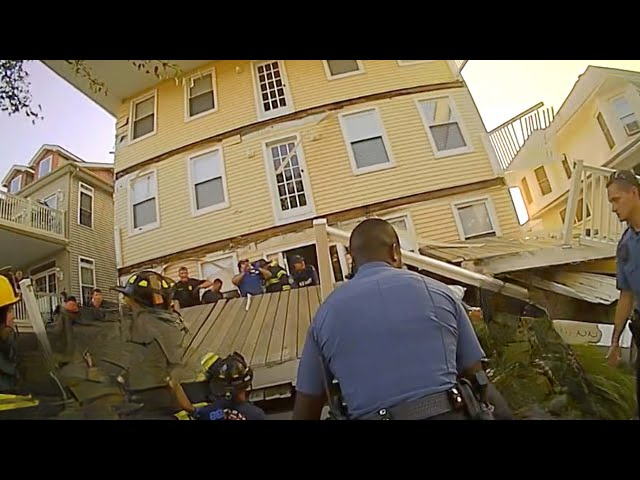Life often unfolds in unexpected ways, with moments of joy sometimes turning into scenes of crisis in a matter of seconds. One such event recently drew national attention when a balcony gave way during a social gathering, leaving 22 individuals injured. The disturbing event, later featured on A&E’s Rescue Cam, offered a sobering reminder of the importance of safety awareness, emergency preparedness, and structural responsibility.
While the incident was undoubtedly frightening, it also revealed the resilience of communities, the bravery of bystanders, and the quick action of professional first responders. Beyond the immediate drama of the collapse, the footage and accounts that emerged provide valuable insights into how similar accidents can be prevented in the future.
A Night of Celebration Turns Chaotic
What began as a seemingly ordinary evening quickly spiraled into something no one could have anticipated. Friends and families had gathered on a balcony to enjoy each other’s company, share food, and celebrate life’s little moments. The air was filled with laughter and conversation—until, without warning, the balcony floor shifted beneath them.

Witnesses described the sound as a sharp crack followed by a deafening crash. Within seconds, the balcony gave way, sending dozens of people tumbling down. The joyous atmosphere was instantly replaced by screams, confusion, and the frantic rush to help those who were injured.
“It felt like the ground disappeared under our feet,” one survivor recalled. “One moment, we were taking photos and laughing, and the next, everything was upside down.”
Eyewitness Reactions
The power of eyewitness testimony lies not only in capturing the immediacy of an event but also in reflecting the human emotions tied to it. Several people who were present recalled the sheer disbelief as the structure collapsed.
One bystander, standing inside the home when the balcony gave way, described seeing a wave of bodies fall almost in slow motion. “I froze for a second. Then I heard the cries for help, and my instincts kicked in. Everyone ran outside, trying to lift debris, check on people, and call 911.”
Another neighbor recounted rushing to the scene with first aid supplies. “It was terrifying, but at the same time, you just act. You don’t think about fear; you think about helping.”
Swift Emergency Response
Emergency responders arrived within minutes of the first calls. Firefighters, paramedics, and law enforcement quickly secured the area, ensuring that no further collapse would endanger rescuers or victims.

A&E’s Rescue Cam highlighted the coordinated teamwork on display: firefighters assessing the stability of the remaining structure, paramedics treating wounds on-site, and police officers directing traffic and crowd control. Stretchers were brought in, and injured individuals were rushed to nearby hospitals for further treatment.
Doctors later reported that while many suffered broken bones, bruises, and concussions, there were fortunately no fatalities. This outcome was largely attributed to the swift arrival and professionalism of first responders.
Understanding Balcony Failures
While the dramatic collapse caught public attention, experts emphasized that this was not merely a freak accident. Structural failures can occur for a number of reasons, and often, they are preventable. Common causes include:
Overcrowding – Balconies are designed with specific weight limits. Exceeding these limits, especially during large gatherings, can put undue stress on the structure.
Poor Construction or Materials – Inadequate building materials or shortcuts in construction can weaken the integrity of a balcony over time.
Lack of Maintenance – Wood rot, rust, and corrosion can go unnoticed if inspections are not routinely carried out.
Weather Damage – Exposure to rain, snow, and fluctuating temperatures gradually weakens outdoor structures.
An engineering consultant interviewed after the collapse noted: “These types of accidents are reminders that regular inspections, adherence to building codes, and responsible use of structures are not optional—they’re lifesaving.”
The Human Impact
Beyond the statistics of 22 people injured lies the very real human impact of the incident. Families were shaken, lives were disrupted, and many survivors faced weeks or months of recovery.
Several individuals sustained broken arms and legs, while others were left dealing with the psychological aftermath. Survivors spoke about being hesitant to gather on balconies or even stand near railings after the experience.
Mental health professionals often point out that traumatic events like this can leave long-lasting impressions, even on those who were not physically injured. Post-traumatic stress, anxiety, and fear of crowds or gatherings are common reactions after such sudden disasters.
Learning From the Past
History shows that balcony and deck collapses are not isolated events. Over the years, there have been multiple high-profile accidents in different parts of the world, each drawing attention to the need for stronger safety regulations.
For instance:
In some cases, large gatherings on older wooden decks led to catastrophic failures.
In urban areas, improper renovations have sometimes compromised the stability of multi-story balconies.
In tourist destinations, poorly maintained rental properties have collapsed under the weight of seasonal crowds.
Each tragedy underscores the importance of proactive safety checks, homeowner responsibility, and public awareness.
The Role of Media and Public Awareness
Programs like Rescue Cam serve a unique role in not just documenting dramatic moments but also educating the public. Viewers see firsthand how quickly accidents can happen and how vital it is to respond correctly in moments of crisis.
The video of the balcony collapse, though difficult to watch, has already sparked conversations in online communities about building safety, emergency preparedness, and crowd management. Many viewers expressed gratitude for the reminder that safety should never be taken for granted.
Safety Measures for Homeowners and Residents
Experts recommend several practical steps to help reduce the risk of similar incidents:
Regular Inspections – Have balconies and decks checked by licensed professionals at least once every few years.
Respect Weight Limits – Avoid overcrowding and remember that furniture, grills, and decorations also add weight.
Look for Warning Signs – Creaking noises, visible cracks, or rust around fasteners can all be signs of trouble.
Maintain Proper Drainage – Ensure water doesn’t pool on wooden surfaces, which can lead to rot.
Stay Informed – Keep up with local building codes and ensure that renovations are done by certified contractors.
Resilience and Community Spirit
In the aftermath of the balcony accident, one of the most striking takeaways was the resilience displayed by the community. Neighbors opened their doors to provide shelter for victims while waiting for ambulances. Volunteers donated food and supplies to families who spent hours in hospitals.
Such moments of unity serve as a powerful reminder that while accidents can divide seconds from safety and disaster, the strength of human compassion often shines brightest during crises.
Broader Reflections
This incident is not just about a single night or a single collapse—it’s about broader lessons society can draw. Structural safety affects everyone, whether in private homes, apartment complexes, or public venues. Each time an accident like this occurs, it serves as a wake-up call to demand higher accountability, improved safety standards, and greater awareness.
Balcony collapses, while rare, highlight the intersection of human joy and human vulnerability. They remind us that behind every brick and beam are lives that depend on structural integrity.
Conclusion: A Call for Vigilance
The collapse that injured 22 people will not soon be forgotten. While the physical wounds will eventually heal, the lessons learned should remain at the forefront of public consciousness. Accidents like these challenge us to ask important questions:
Are we doing enough to ensure the safety of our living spaces?
Do homeowners, landlords, and contractors fully understand their responsibilities?
How can communities stay better prepared for emergencies?
By addressing these questions, society can turn tragedy into progress. Ultimately, the balcony accident captured on Rescue Cam stands as a poignant reminder: safety is never guaranteed, but vigilance, responsibility, and preparedness can go a long way in protecting lives.



